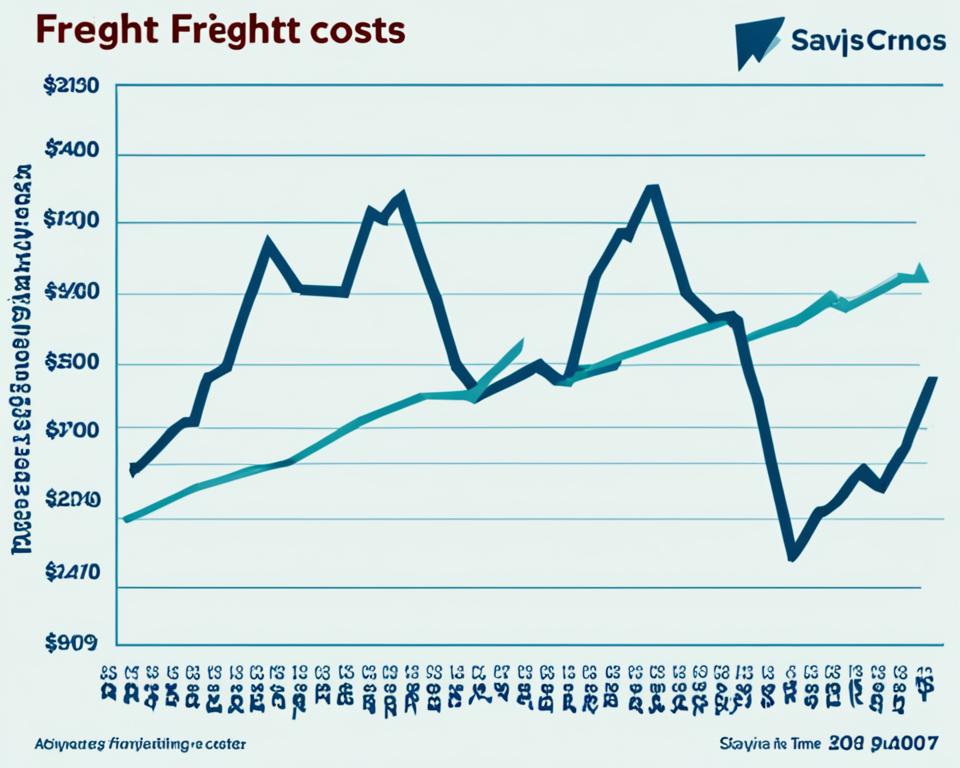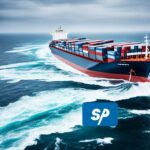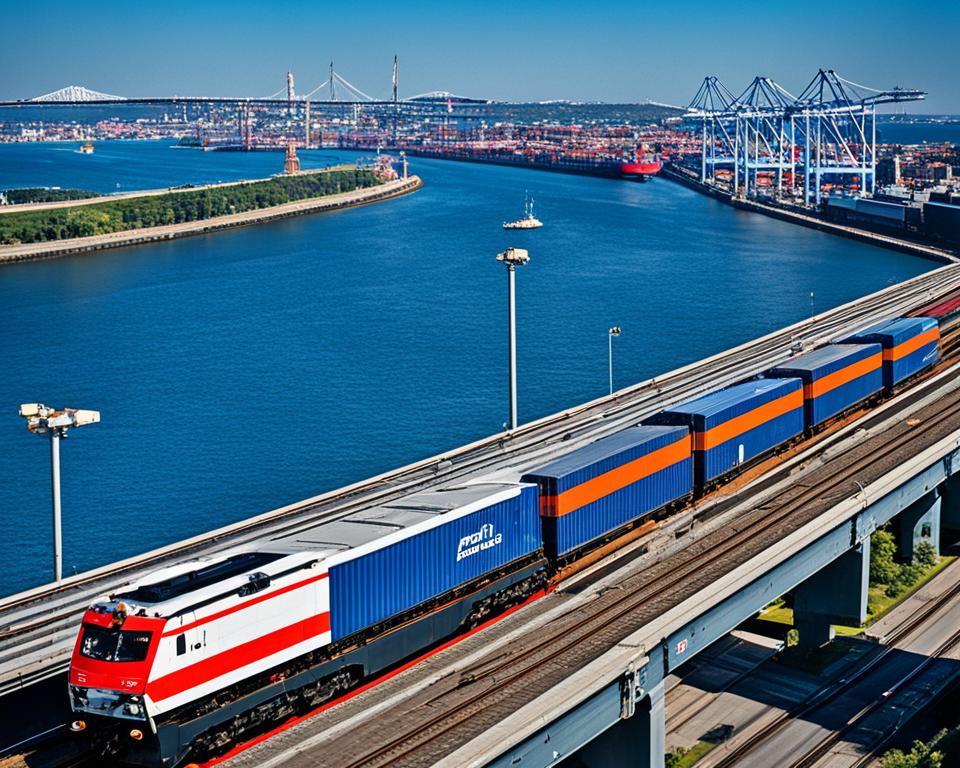Ever thought about the hidden inefficiencies in your transportation management? In today’s fast world, knowing this could change everything. SAP TM, or SAP Transportation Management, is more than software. It’s a game-changer that makes logistics better.
With SAP TM, businesses like mine can work smarter, save money, and serve customers better. It offers tools like real-time tracking and route optimization. These tools help me make better decisions in freight management.
Key Takeaways
- SAP TM significantly improves transportation management efficiency.
- Real-time tracking offers enhanced visibility throughout the supply chain.
- Logistics optimization leads to reduced operational costs.
- Route optimization capabilities ensure timely deliveries.
- Actionable analytics drive informed business decisions.
- Improved customer service satisfaction through reliable freight management.
Understanding Transportation Management in Today’s Logistics
Transportation management is key to a successful supply chain. It involves planning and optimizing how goods move. With the market changing, it’s vital for logistics efficiency and making customers happy. Using advanced tech like SAP TM can make things smoother and handle today’s logistics challenges.
For transportation management to work well, you need:
- Route optimization: Finding the best delivery paths cuts costs and boosts service levels.
- Carrier negotiations: Good relationships with carriers mean better rates and quality service.
- Real-time visibility: Tracking shipments live gives insights and keeps customers updated.
These steps boost logistics efficiency and strengthen supply chain management. They help businesses meet market needs and adapt to changes.
| Key Element | Description | Impact on Logistics Efficiency |
|---|---|---|
| Route Optimization | Identifying the best routes for deliveries. | Reduces transportation costs and delivery times. |
| Carrier Negotiations | Establishing advantageous terms with transportation providers. | Improves service levels and reduces overall spend. |
| Real-Time Visibility | Monitoring shipments throughout the delivery process. | Enhances customer satisfaction and reduces uncertainty. |
The Importance of Logistics Optimization
Logistics optimization is key to boosting efficiency and success in today’s market. It helps cut costs and improve service levels. This makes it vital for both making profits and keeping customers happy.
There are many ways to make logistics better. Using technology is a big step. It helps track things better and automates tasks, saving time.
Improving how we manage inventory is also crucial. By keeping the right amount of stock, we avoid extra costs and stockouts. This balance is key to a smooth supply chain.
Running warehouses efficiently is also important. Organizing products well and using the right equipment makes getting and sending out products faster. This makes customers happier.
To show how logistics optimization helps, I’ve compared some key numbers before and after making changes:
| Key Performance Indicator | Before Optimization | After Optimization |
|---|---|---|
| Order Fulfillment Time | 5 Days | 2 Days |
| Transportation Costs | 20% of Revenue | 15% of Revenue |
| Inventory Turnover Ratio | 4 | 6 |
Looking closely at each part of the supply chain and making improvements can greatly boost performance. This keeps companies competitive and successful in a changing market.
What is SAP TM?
SAP TM, or SAP Transportation Management, is a top-notch software for managing transportation. It helps plan, execute, and keep an eye on transportation activities. This makes it key for businesses wanting to improve their freight management.
So, what is SAP TM? It’s a cloud-based solution that works well with other SAP modules. This lets companies grow their transportation management smoothly. It also makes handling data better and streamlines processes across departments, boosting efficiency.
At the heart of SAP Transportation Management are several key parts:
- Order Management
- Transportation Planning
- Shipment Execution
- Payment Processes
These tools help businesses tackle supply chain issues better. With advanced analytics for making decisions, companies can use data to track performance and cut costs. For those looking to improve their procurement, using SAP TM with SAP Ariba can help a lot in managing supplier relationships. Learn more about improving supplier collaboration with advanced technology here.
Key Features of SAP TM
SAP TM has many strong features that change how companies handle transportation. It helps with advanced route planning, cutting down on transport costs and making deliveries more efficient. It also supports managing different transport modes, making logistics smoother across various transport types.
Choosing the right carriers is a big deal in SAP TM. It lets users pick the best carriers by looking at costs, reliability, and performance. This helps companies make choices that fit their goals.
Keeping track of shipments is key with SAP TM’s freight visibility. It’s vital for companies that want to watch their shipments as they move. SAP TM uses data analytics to help companies understand transport performance. This helps them make better decisions and improve their strategies.

| Feature | Description |
|---|---|
| Advanced Route Planning | Optimizes routes to minimize costs and time, balancing factors such as distance and delivery windows. |
| Multimodal Transportation Management | Supports various transportation modes, enhancing flexibility and cost-efficiency. |
| Carrier Selection and Optimization | Facilitates informed choices regarding carriers based on performance metrics and pricing. |
| Comprehensive Shipment Tracking | Delivers real-time insight into shipment status, promoting transparency and improving customer satisfaction. |
| Data Analytics Integration | Enhances decision-making through insights derived from transportation performance data. |
Enhancing Freight Management with SAP TM
Effective freight management is key to cutting down on transportation costs and boosting delivery times. SAP TM brings big benefits to managing freight. It lets me track freight in real-time, making logistics less uncertain.
SAP TM also helps combine carrier pricing into the freight management process. This gives me clear insights into costs, helping me make smart choices within my budget. It keeps operations running smoothly and avoids unexpected costs.
Analytics in SAP TM are a game-changer for making decisions. They let me look at key metrics that affect freight management. This helps me understand trends and how well operations are doing. It’s a data-driven way to spot areas for improvement and keep customers happy with timely deliveries.
In short, SAP TM brings big improvements in tracking, cost control, and making smart choices. My experience shows it can change how companies handle freight logistics.
Accelerating Route Planning using SAP TM
Planning efficient routes is key in modern logistics. It affects both the cost of transport and how fast goods arrive. With SAP TM route optimization, businesses can make their route planning better. SAP TM uses advanced algorithms to look at many possible routes.
This helps pick the best routes by considering things like:
- Traffic conditions
- Fuel costs
- Delivery deadlines
By thinking about these things in their planning, companies can make big improvements in logistics efficiency. Being able to change routes on the fly cuts down on transport costs and boosts service levels. Using SAP TM for planning routes makes operations smoother and betters the whole supply chain.

Optimizing Carrier Selection in Transportation
Choosing the right carriers is key to better transportation. With SAP TM, companies can pick the best carriers by looking at cost, reliability, and service. This ensures they meet company goals and customer needs.
Criteria for Selecting Carriers
When picking carriers, I look at a few important things:
- Cost – I check the prices of different carriers to find ones that fit the budget.
- Reliability – I look at how often carriers deliver on time to make sure they’re dependable.
- Service Levels – It’s important to check the quality of service, like customer support and communication.
Integrating Carrier Performance Metrics
Using carrier performance metrics helps make better choices. I track things like on-time delivery rates and how often goods get damaged. This info helps pick the best carriers and keeps improving. Having strong relationships with reliable carriers is key to good transportation management.
Effective Shipment Tracking with SAP TM
In today’s fast world, keeping track of shipments is key for smooth operations. SAP TM gives businesses strong tools for tracking shipments in real-time. This means everyone knows where shipments are at all times. It makes logistics more visible, helping companies deal with problems fast.
Knowing where shipments are at every step makes customers happy. When I know exactly where a shipment is, I can tell my clients right away. This builds trust and makes things clear. Plus, tracking in real-time lets us change plans quickly, cutting down on delays and making routes better.
Let’s look at how SAP TM’s shipment tracking helps:
| Benefit | Impact on Logistics |
|---|---|
| Enhanced Visibility | Improved understanding of shipment locations and potential delays. |
| Proactive Issue Resolution | Ability to address problems before they escalate, reducing disruptions. |
| Data-Driven Decisions | Utilization of tracking data to optimize future shipments. |
| Increased Customer Confidence | Providing up-to-date information leads to higher customer satisfaction. |
Using SAP TM to link shipment tracking with other logistics steps gives deep insights and big benefits. Putting in real-time tracking tech helps businesses win in a tough market.
![]()
The Role of Transportation Analytics
Transportation analytics is key in modern logistics management. It helps me make operations more efficient and cost-effective. By using data well, I can improve decision-making and adjust to the changing supply chain needs.
Data-Driven Decision Making in Logistics
Data-driven decisions are vital for handling logistics challenges. Analyzing real-time data helps me spot trends and patterns that affect efficiency. This leads to better use of resources, lower costs, and higher service levels.
Companies that use transportation analytics gain a big edge. They stay ahead in the competition.
How Analytics Enhance Supply Chain Visibility
Seeing the whole supply chain clearly is key for working well with others. Transportation analytics gives a full view of logistics, improving communication and transparency. It helps track shipments and predict supply chain issues.
This way, I can make smart choices that boost performance and make the supply chain more flexible and quick to respond.
SAP TM: Streamline Your Transportation Management
SAP TM is key to improving logistics operations. It has features that make processes smoother. With advanced analytics, it gives real-time insights to boost mission success.
This solution does more than track and manage. It automates routine tasks, letting my team work on growth strategies. The easy-to-use interface gives quick access to important data, helping make better decisions.
Using SAP TM has big benefits. It links transportation management with business goals, making logistics a key part of success. Here’s a table showing some main advantages of SAP TM.
| Feature | Benefit |
|---|---|
| Integrated Analytics | Improves visibility and supports data-driven logistics. |
| Automated Workflows | Makes things more efficient by reducing manual work. |
| Real-time Tracking | Keeps everyone updated and helps solve logistics issues quickly. |
| Carrier Management | Helps pick carriers wisely, saving money on transport. |
In conclusion, SAP TM helps organizations do logistics better. It leads to clear results that improve mission success.
Transport Execution and Its Impact on Performance
Effective transport execution is key to better logistics performance. It ensures all logistics steps, from dispatch to delivery, run smoothly. This means goods move on time and delays are cut down.
Tools like SAP TM make managing transport easier. They let companies track progress and make quick changes if needed. This way, businesses can keep up with customer needs and hit high performance goals.
Several key elements make transport execution successful:
- Coordination of resources: Using vehicles and staff well is crucial for efficient transport.
- Real-time tracking: This lets companies watch shipments closely, keeping them on track.
- Communication: Good communication helps respond fast to changes or issues that affect logistics.
Strong execution processes boost transport efficiency and overall operation. By focusing on these, businesses can greatly improve their logistics and stay ahead in the market.
Freight Costing and Budget Management
Effective freight costing and budget management are key to a business’s financial health. They help keep profits up and prices competitive. SAP Transportation Management (TM) helps with budgeting and controlling costs.
SAP TM makes understanding transportation costs easy. It lets me track spending and predict future costs. This makes operations smoother and helps with planning and making decisions.

| Feature | SAP TM | Traditional Methods |
|---|---|---|
| Data Integration | Real-time updates | Manual entry and updates |
| Cost Analysis | Automated insights | Time-consuming calculations |
| Budget Forecasting | Dynamic adjustments | Static estimates |
| Supplier Collaboration | Streamlined communication | Disjointed interactions |
Using SAP TM helps me manage transportation costs well. It keeps budgeting efficient and clear. In today’s economy, managing these two well is crucial for success.
For more on improving your procurement and the benefits of tools like SAP Ariba, check out this link.
Building a Robust Supply Chain Visibility Framework
In today’s fast-paced world, having a strong supply chain visibility framework is key. It helps us see where goods are at all times. This makes operations run smoother. Using SAP TM can make logistics clearer, letting companies track shipments and manage stock better.
- Improve inventory management by providing real-time data on product locations.
- Enhance order fulfillment processes through accurate tracking of shipments.
- Strengthen relationships with suppliers and customers by fostering transparent communication.
Having clear supply chain visibility helps make better decisions and builds trust with everyone involved. From what I’ve seen, this approach improves logistics and boosts a company’s image. A visibility framework is key to staying competitive in logistics.
Real-World Applications of SAP TM
SAP TM has changed the game in logistics and supply chain management across different industries. It helps companies solve unique problems, making things more efficient and pleasing customers.
A global manufacturing giant used SAP TM to make their logistics better. They cut down on transport costs and made their operations clearer. This shows how SAP TM can save money and help companies meet market needs fast.
Another company, in retail, used SAP TM to track shipments and pick the best carriers. This led to better delivery routes and talks with suppliers. Customers became more loyal because of this.
Companies show they can handle complex supply chains with SAP TM. This tech helps them do better and build strong supplier relationships. SAP TM keeps adding new features, making logistics better and proving it’s a top choice for managing transport.
For more on how tech changes procurement, check out this guide on SAP Ariba. It talks about how making procurement more efficient helps with transportation management.
Future Trends in Transportation Management
Transportation management is set for a big change thanks to new tech. Future trends in logistics will bring in artificial intelligence, machine learning, and the Internet of Things (IoT). These will change how we manage logistics and make transportation systems like SAP TM more efficient.
Adding transportation technology will make things run smoother. It will let companies analyze data in real-time and make better choices. This means they can meet customer needs better and work more efficiently. Looking at success stories, like those with SAP Ariba, shows how to improve buying and get real benefits in industries like making things and selling them.
For more info, check out successful procurement practices.
Looking forward, we’ll focus on:
- More automation in logistics.
- Better supply chain visibility with predictive analytics.
- Green practices in supply chain evolution.
These changes will shape the future trends in logistics. They will give companies the edge they need. As transportation management changes, companies must use these new tools to stay competitive.
| Trend | Description | Impact on Supply Chain |
|---|---|---|
| AI and Machine Learning | Improves predictive analytics and decision-making. | Makes operations more efficient and cuts costs. |
| IoT Integration | Tracks and monitors logistics assets in real-time. | Increases visibility and quickens supply chain responses. |
| Sustainability Initiatives | Uses eco-friendly practices in transport. | Lowers carbon emissions and meets regulations. |
Conclusion
SAP TM plays a key role in making transportation management better. It helps by automating tasks and cutting down on delays. This leads to big cost savings for companies.
It also makes the supply chain more visible. With real-time data, businesses can make quick, smart choices. This gives them an edge in a fast-changing market.
Looking back, SAP TM is a game-changer for companies aiming for top-notch logistics. By using SAP TM, companies can handle the challenges of modern transportation and logistics better.
FAQ
What is SAP TM?
SAP TM, or SAP Transportation Management, is a software solution for better transportation management. It automates key tasks like planning routes, picking carriers, and tracking shipments. This leads to lower costs and better customer service.
How does SAP TM optimize freight management?
SAP TM gives real-time updates on shipments and their costs. It uses data analytics to help businesses choose the best carriers and manage transportation better. This results in faster deliveries and lower costs.
What are the key features of SAP TM?
SAP TM has advanced route planning, carrier selection, real-time tracking, and detailed analytics. These features help businesses improve logistics, see freight better, and work more efficiently.
How does SAP TM aid in route planning?
SAP TM uses smart algorithms to find the best routes. It considers traffic, fuel costs, and deadlines. This makes logistics more efficient and cuts down on costs.
What role does transportation analytics play in SAP TM?
Transportation analytics in SAP TM helps make decisions based on data. It spots trends and inefficiencies in logistics. This makes supply chains more visible and efficient, helping everyone work better together.
How can I track shipments effectively using SAP TM?
With SAP TM, you can track shipments in real-time. This makes logistics more visible and efficient. It keeps clients updated and helps solve problems during transit.
Why is carrier selection important in transportation management?
Choosing the right carrier is key for costs, reliability, and customer happiness. SAP TM helps by giving metrics to check carrier performance. This ensures businesses pick the best for their needs.
What is the importance of logistics optimization in supply chains?
Logistics optimization is key for better service and lower costs. It boosts efficiency in the supply chain by focusing on inventory, transportation, and warehouses.
How can SAP TM improve supply chain visibility?
SAP TM gives a full view of goods moving through the supply chain. It uses data and real-time tracking to manage inventory better, improve order fulfillment, and strengthen customer and supplier relationships.



